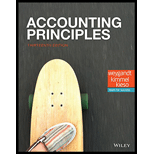
EBK ACCOUNTING PRINCIPLES
13th Edition
ISBN: 9781119411017
Author: Weygandt
Publisher: WILEY
expand_more
expand_more
format_list_bulleted
Question
Chapter 4, Problem 3IFRE
To determine
Introduction: Accounting is a process under which the financial transactions are identified, recorded, analyzed, and summarized; and at the end of the year, the financial results are reported. The various financials prepared at the end of the year are the
To prepare: The current assets section of the balance sheet.
Expert Solution & Answer
Want to see the full answer?
Check out a sample textbook solution
Students have asked these similar questions
Garrison Enterprises has a net profit margin of 6%, a total asset turnover of 1.8 times, and a debt ratio of 30%. What is its return on equity? Don't Use Ai
The total assets are?
Garrison Enterprises has a net profit margin of 6%, a total asset turnover of 1.8 times, and a debt ratio of 30%. What is its return on equity?
Chapter 4 Solutions
EBK ACCOUNTING PRINCIPLES
Ch. 4 - Prob. 1QCh. 4 - 2. Explain the purpose of the worksheet.
Ch. 4 - 3. What is the relationship, if any, between the...Ch. 4 - Prob. 4QCh. 4 - Prob. 5QCh. 4 - Prob. 6QCh. 4 - Prob. 7QCh. 4 - Prob. 8QCh. 4 - 9. Which of the following accounts would not...Ch. 4 - 10. Distinguish between a reversing entry and an...
Ch. 4 - Prob. 11QCh. 4 - Prob. 12QCh. 4 - Prob. 13QCh. 4 - Prob. 14QCh. 4 - Prob. 15QCh. 4 - Prob. 16QCh. 4 - Prob. 17QCh. 4 - Prob. 18QCh. 4 - Prob. 20QCh. 4 - Prob. 21QCh. 4 - BE4-1 The steps in using a worksheet are presented...Ch. 4 - Prob. 2BECh. 4 - Prob. 3BECh. 4 - Prob. 4BECh. 4 - Prob. 5BECh. 4 - Prob. 6BECh. 4 - Prob. 7BECh. 4 - BE4-8 The steps in the accounting cycle are listed...Ch. 4 - Prob. 9BECh. 4 - Prob. 10BECh. 4 - Prob. 11BECh. 4 - Prob. 12BECh. 4 - Prob. 1DIECh. 4 - Prob. 2DIECh. 4 - DO IT! 4-3 Hanson Company has an inexperienced...Ch. 4 - Prob. 4DIECh. 4 - Prob. 1ECh. 4 - E4-2 The adjusted trial balance columns of the...Ch. 4 - E4-3 Worksheet data for Savaglia Company are...Ch. 4 - E4-4 Worksheet data for Savaglia Company are...Ch. 4 - Prob. 5ECh. 4 - Prob. 6ECh. 4 - Prob. 7ECh. 4 - Prob. 8ECh. 4 - Prob. 9ECh. 4 - E4-10 Renee Davis has prepared the following list...Ch. 4 - Prob. 11ECh. 4 - Prob. 12ECh. 4 - Prob. 13ECh. 4 - Prob. 14ECh. 4 - Prob. 15ECh. 4 - Prob. 16ECh. 4 - Prob. 17ECh. 4 - Prob. 18ECh. 4 - Prob. 19ECh. 4 - P4-1A The trial balance columns of the worksheet...Ch. 4 - P4-3A The completed financial statement columns of...Ch. 4 - P4-5A Anya Clark opened Anya’s Cleaning Service on...Ch. 4 - Prob. 7EYCTCh. 4 - Prob. 1ISTQCh. 4 - Prob. 2ISTQCh. 4 - Prob. 3ISTQCh. 4 - Prob. 4ISTQCh. 4 - Prob. 1IFRECh. 4 - Prob. 2IFRECh. 4 - Prob. 3IFRECh. 4 - Prob. 4IFRE
Knowledge Booster
Similar questions
- Dakota Manufacturing had 3,120 units, one-fourth completed at the beginning of the period. 14,580 units were transferred to Department Y from Department X during the period, and 680 units were one-third completed at the end of the period. What is the total number of units to be assigned cost on the cost of production report for Department X?arrow_forwardKindly help me with accounting questionsarrow_forwardGarrison Enterprises has a net profit margin of 6%, a total asset turnover of 1.8 times, and a debt ratio of 30%. What is its return on equity? Need solutionarrow_forward
arrow_back_ios
SEE MORE QUESTIONS
arrow_forward_ios
Recommended textbooks for you

 AccountingAccountingISBN:9781337272094Author:WARREN, Carl S., Reeve, James M., Duchac, Jonathan E.Publisher:Cengage Learning,
AccountingAccountingISBN:9781337272094Author:WARREN, Carl S., Reeve, James M., Duchac, Jonathan E.Publisher:Cengage Learning, Accounting Information SystemsAccountingISBN:9781337619202Author:Hall, James A.Publisher:Cengage Learning,
Accounting Information SystemsAccountingISBN:9781337619202Author:Hall, James A.Publisher:Cengage Learning, Horngren's Cost Accounting: A Managerial Emphasis...AccountingISBN:9780134475585Author:Srikant M. Datar, Madhav V. RajanPublisher:PEARSON
Horngren's Cost Accounting: A Managerial Emphasis...AccountingISBN:9780134475585Author:Srikant M. Datar, Madhav V. RajanPublisher:PEARSON Intermediate AccountingAccountingISBN:9781259722660Author:J. David Spiceland, Mark W. Nelson, Wayne M ThomasPublisher:McGraw-Hill Education
Intermediate AccountingAccountingISBN:9781259722660Author:J. David Spiceland, Mark W. Nelson, Wayne M ThomasPublisher:McGraw-Hill Education Financial and Managerial AccountingAccountingISBN:9781259726705Author:John J Wild, Ken W. Shaw, Barbara Chiappetta Fundamental Accounting PrinciplesPublisher:McGraw-Hill Education
Financial and Managerial AccountingAccountingISBN:9781259726705Author:John J Wild, Ken W. Shaw, Barbara Chiappetta Fundamental Accounting PrinciplesPublisher:McGraw-Hill Education


Accounting
Accounting
ISBN:9781337272094
Author:WARREN, Carl S., Reeve, James M., Duchac, Jonathan E.
Publisher:Cengage Learning,

Accounting Information Systems
Accounting
ISBN:9781337619202
Author:Hall, James A.
Publisher:Cengage Learning,

Horngren's Cost Accounting: A Managerial Emphasis...
Accounting
ISBN:9780134475585
Author:Srikant M. Datar, Madhav V. Rajan
Publisher:PEARSON

Intermediate Accounting
Accounting
ISBN:9781259722660
Author:J. David Spiceland, Mark W. Nelson, Wayne M Thomas
Publisher:McGraw-Hill Education

Financial and Managerial Accounting
Accounting
ISBN:9781259726705
Author:John J Wild, Ken W. Shaw, Barbara Chiappetta Fundamental Accounting Principles
Publisher:McGraw-Hill Education